Do you remember the story of the goldfish that fulfills 3 wishes? A goldfish doesn’t just have to be gold at all. It can also be very colorful. You don’t understand? The famous goldfish is a species of Koi carp whose popularity and breeding have reached their peak in recent years. However, we must be careful with the breeding of these fish – especially when it comes to other fish with which they should coexist. So it is not surprising that many ask the question, can Koi fish live with other fish?
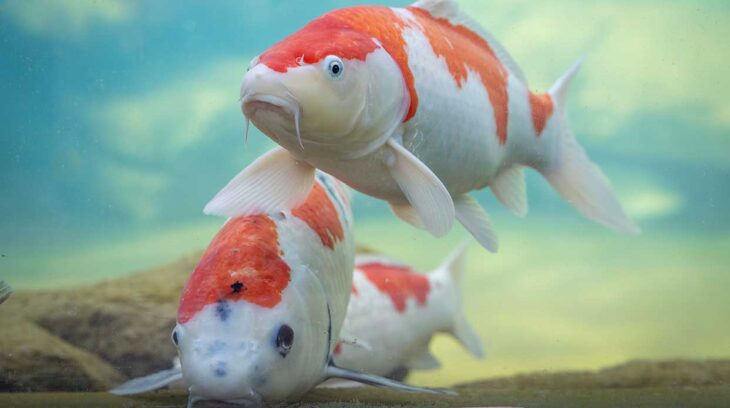
Source: medium.com
Contents [show]
Koi Carp Is Not A Fish For Aquarium
Although they are very popular today, and at the same time quite expensive – Koi fish are not very desirable inhabitants of the aquarium. The reason for such a thing is primarily their size. Namely, Koi fish is a large cold-water fish that requires a natural environment. When we say natural environment, we mean primarily a water space in which they can move, feed, and hunt.
Certain specimens of Koi fish can grow to a considerable extent, so it is almost impossible to keep them in an aquarium – unless you have one of 500 liters or more, which we are sure is not the case. Koi fish need a lot of water, and it is not surprising that in recent years, the popularity of ponds or pools and the accumulation for breeding these fish has increased among the breeders of these fish. If you have space to make a pond or a small lake for your Koi fish – it will certainly be the most beautiful part of your garden.
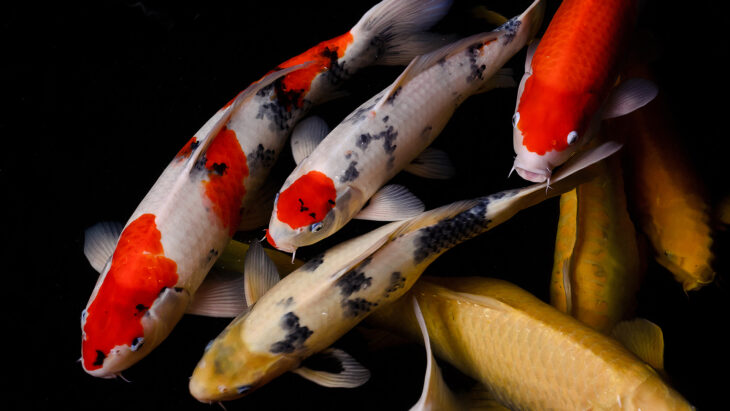
Source: animals.sandiegozoo.org
Where Does Koi Fish Come From?
Koi Carp is a group of fish originally found in East Asia, where they were used for food. Japanese carp, Koi carp, or as the Japanese call it Nishikigoi, is an ornamental variety of domestic carp. The word Koi comes from the Japanese language and means “carp”, and also has the meaning of “affection” and “love” – and at the same time symbolizes happiness. Perhaps this is where the legend that the goldfish (Koi) brings happiness and fulfills desires originated.
Koi fish are grown for decorative purposes in the open and therefore require places such as ponds, lakes, or water gardens. People who are a little more serious about aquaristics and fish breeding emphasize that growing Koi fish requires space and somewhat colder water – but not extreme conditions. The most ideal depth of the pond is 72 inches – but for some climates, 32 inches of depth can be enough. The volume of the pond should be about 10 m3. So plenty of space and plenty of water. And how do Koi get along with other fish? Well … that can be a small problem.
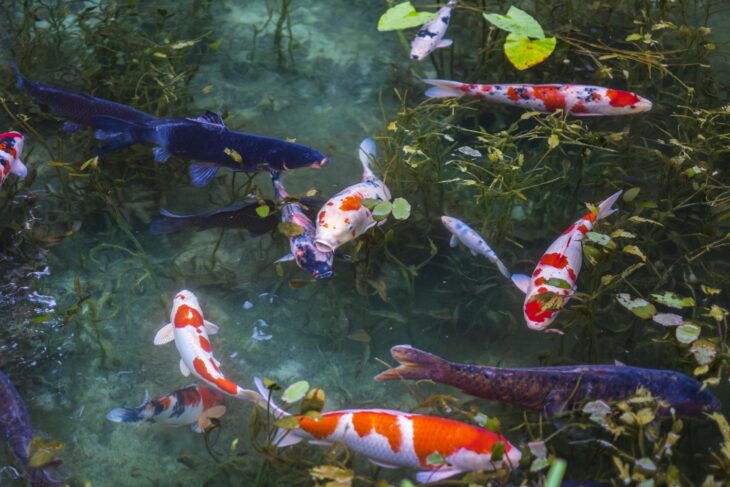
Source: blog.japanwondertravel.com
Coexistence With Other Fish
It’s not that they are not friendly, but the rule of the stronger applies to them. So, the bigger fish always eats the smaller one. Just like in the case of their smaller cousin the goldfish – Koi carp have the same problem. This fish is awkward with the neighbors. You can click here and see that these fish are omnivorous. That means you should not be surprised by the fact that they also feed on smaller fish – which is very inconvenient for the aquarium. Also, their size is not adjusted to keep them in the aquarium because they can grow about 27 inches. Even if you have a giant aquarium, don’t expect other fish to stay in it after a while when the Koi outgrows them.
Therefore, it is best to have a pond in which you will keep only Koi specimens. This can be very decorative because Koi fish can be very colorful – and they will be a true attraction – especially during feeding when they jump on the surface of the pond. And speaking of feeding – here’s how to feed them.
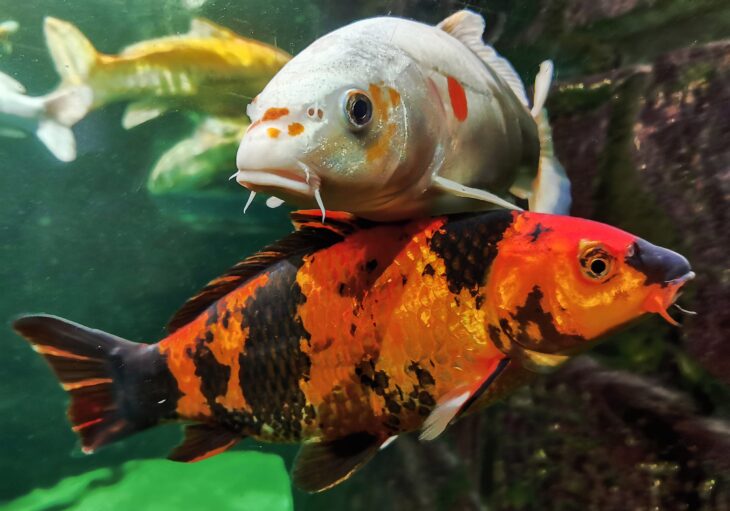
Source: kcpinternational.com
Nutrition
As we have already pointed out, these fish are omnivores. This practically means that they will eat almost everything they can get their hands on (sorry, fins) – as if they are in the wild and nature. Their diet includes algae, other plants, and insects – but also other fish that are smaller than them. If you keep them as pets or breed Koi carp – you must keep in mind that a balanced diet is necessary for longevity.
These fish can live up to 40 years. Of course, this doesn’t happen so often in nature – but when kept in ponds, it is almost a normal thing. Of course, if you take care of the diet and care of these fish. Nutrition is also important because of the attractive color patterns by which these fish are known – and this can be a good indicator to improve the nutrition of these fish if necessary.
Most importantly, make a good balance between protein and plants to make the best combination of diets that will contribute to their growth and vibrant colors. There is food for them that you can buy, but they also eat garden worms and peas. They are not very picky and they grow pretty quick.
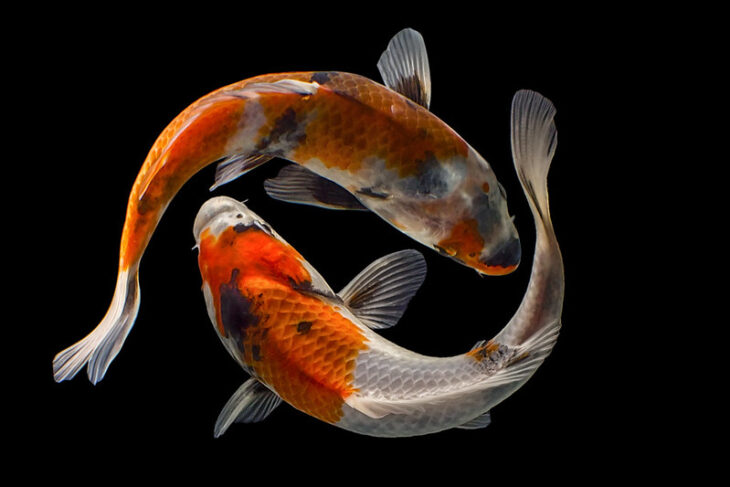
Source: kcpinternational.com
In Winter, They Retreat Into Hibernation
This ornamental version of carp, as it turned out, can survive in different climates. Winter is not a problem for them. Koi carp hibernate during the winter – so they need to be provided with sufficient depth of the pool or pond. It is because they will retreat when the water freezes on the surface.
According to a rough calculation, every 7.5 to 8 inches of water depth, the temperature is one degree higher, and 39 degrees is needed for hibernation. The thickness of the ice on the water surface should not be calculated into this particular formula – because it can change according to the weather conditions. If the winters are really cold, you need to know that the ice on the surface is not at all a negligible factor.

The Bottom Line
We hope that you are now a little better acquainted with this type of aquarium fish. Although they are not very suitable for an aquarium due to their size, nor are they too friendly with other fish – people still breed them more and more because of their beauty, vivid colors, and cheerful nature. In 2020, Koi carp was declared the national fish of Japan. Today, there are entire provinces in Japan where people have been producing Koi carp for generations. The most expensive specimens reach a price of an incredible two million dollars and become a status symbol.
